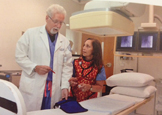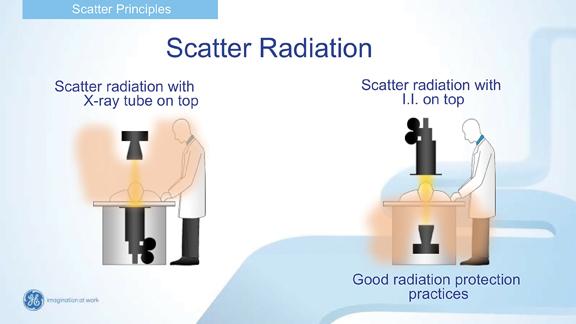
Assistant Radiation Safety Officer Roseann Zeldin \"lights a fire\" for radiation safety.
The Hospital for Special Surgery (HSS) in New York, N.Y., consistently ranks No. 1 on the U.S. News & World Report list of best orthopedic hospitals in the United States. The hospital performs thousands of surgeries every year, and those procedures require leading-edge imaging technology. HSS currently uses 20 GE OEC fluoroscopy systems in its operating suites. That’s a lot of imaging, and a big challenge for a department whose motto is “every procedure starts with low dose.”
Radiation safety is a priority for HSS, but it takes education and supervision to help physicians and technologists follow best practices to keep radiation to an absolute minimum. Roseann Zeldin, RT, (R)(M), CNMT, the assistant radiation safety officer at HSS, takes a hands-on approach to monitoring radiation safety. Although she’s sometimes called “the radiation police,” providers at the hospital know that she’s there to protect patients and to protect them.
In May 2013, Zeldin coordinated with GE Healthcare to provide the surgical teams with training through the GE OEC “Brilliant” radiation safety program. The program’s goal is to reduce radiation exposure through education and built-in features on the imaging equipment.
Training Started With Technologists, Then Covered Physicians
Education is vital to radiation safety. The HSS team is filled with extremely intelligent, highly educated people, but as Zeldin has discovered, they still need new information to maximize their safety. The Brilliant CEU-credited course gave the HSS staff specific information about how they could reduce exposure. Zeldin explained that the standard C-arm training doesn’t provide in-depth discussion about dose or features that can help reduce dose. The Brilliant training did.
The two-month campaign to get the entire staff trained began with the radiology technologists. The on-site training covered features such as collimation, which reduces the area of the beam using lead shutters; pulse mode, which lowers dose by using pulses of radiation rather than a continuous beam; and the laser aimer, which simply uses a laser to help correctly position the beam over the patient anatomy.
The Brilliant training also presented basic information about radiation distribution, such as inverse-square law calculating the relationship between distance and amount of radiation. One step back from the table can significantly reduce exposure.
After the technologists were trained, physicians and surgeons were hearing about the radiation reducing techniques — so Zeldin set up training for more groups. The turnout among physicians was small at first, but it made an immediate difference. For instance, a few physicians at the hospital sometimes inverted the C-arm so that the beam was above the patient rather than below in an effort to get a clearer image. Zeldin’s favorite slide in the Brilliant presentation showed the difference in scatter when the beam is below the patient and when it is above. During a presentation, she leaned over to a physician and said, “That’s why your radiation level is so high.”
He looked at her in shock. “How did you know?” he asked.
“I know everything!” she joked. She explained that because she monitors the radiation levels and discusses safety with the technologists, she knows what goes on in the operating rooms.
Small Changes in Technique Yield Big Increases in Safety
Following training, there was a new understanding of the benefits of C-arm laser aimers and the radiation reduction potential they present. HSS has had laser aimers for years, but they didn’t get much use. During a Brilliant training, one of the technologists said, “We can’t see where we’re going with that C-arm.” The OEC education shows how the laser can help them position the beam before they take the image — for a more precise image and fewer re-takes. The next day, Zeldin was flooded with calls for laser aimers.
She helped another group of surgeons by telling them to turn down the lights. The Brilliant presentation explained that bright OR lights can compromise image quality by washing out detail, so a low-dose solution to improve image quality is dimming the lights.
Zeldin has overseen the training of 26 physicians and 60 technologists. The staff radiation levels, which used to be around 100 millirems per month, have decreased by about half.
Keep Spreading the Message
Zeldin is developing a yearly, mandatory online course. She is also developing research that will assess the impact of training on radiation exposure, using some of the physicians and other staff who have not yet received training as a sample. One surgeon is also working with her on his own radiation study that will help educate other surgeons in his field.
HSS, a brilliant hospital full of brilliant people, used Brilliant training to improve radiation safety for its patients and its staff.
Case study supplied by GE Healthcare.
Hospital for Special Surgery is a customer of GE Healthcare.



 December 11, 2025
December 11, 2025 









